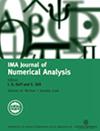Wavelet compressed, modified Hilbert transform in the space–time discretization of the heat equation
IF 2.4
2区 数学
Q1 MATHEMATICS, APPLIED
引用次数: 0
Abstract
On a finite time interval $(0,T)$ we consider the multiresolution Galerkin discretization of a modified Hilbert transform ${\mathscr{H}}_{T}$ that arises in the space–time Galerkin discretization of the linear diffusion equation. To this end, we design spline-wavelet systems in $(0,T)$ consisting of piecewise polynomials of degree $\geq 1$ with sufficiently many vanishing moments that constitute Riesz bases in the Sobolev spaces $ H^{s}_{0,}(0,T)$ and $H^{s}_{,0}(0,T)$. These bases provide stable multilevel splittings of the temporal discretization spaces into ‘increment’ or ‘detail’ spaces. Furthermore, they allow to optimally compress the nonlocal integrodifferential operators that appear in stable space–time variational formulations of initial-boundary value problems, such as the heat equation and the acoustic wave equation. We then obtain sparse space–time tensor-product spaces via algebraic tensor-products of the temporal multilevel discretizations with standard, hierarchic finite element spaces in the spatial domain (with standard Lagrangian FE bases). Hence, the construction of multiresolutions in the spatial domain is not necessary. An efficient multilevel preconditioner is proposed that solves the linear system of equations resulting from the sparse space–time Galerkin discretization with essentially linear complexity (in work and memory). A substantial reduction in the number of the degrees of freedom and CPU time (compared with time-marching discretizations) is demonstrated in numerical experiments.小波压缩后,修正希尔伯特变换在时空离散化中的热方程
在有限时间区间$(0,T)$上,我们考虑了线性扩散方程的时空离散中出现的修正希尔伯特变换${\mathscr{H}}_{T}$的多分辨率伽辽金离散化。为此,我们在$(0,T)$中设计了由次为$\geq 1$的分段多项式组成的样条小波系统,该系统具有足够多的消失矩,构成Sobolev空间$ H^{s}_{0,}(0,T)$和$H^{s}_{,0}(0,T)$中的Riesz基。这些基础为时间离散空间提供了稳定的多层分裂,使其成为“增量”或“细节”空间。此外,它们允许最优地压缩出现在初始边值问题(如热方程和声波方程)的稳定时空变分公式中的非局部积分微分算子。然后,我们通过与空间域(具有标准拉格朗日有限元基)的标准分层有限元空间的时间多层离散化的代数张量积来获得稀疏的时空张量积空间。因此,不需要在空间域中构建多分辨率。提出了一种有效的多层预调节器,用于求解由稀疏时空伽辽金离散所产生的线性方程组,该方程组具有基本的线性复杂度(工作复杂度和内存复杂度)。数值实验表明,与时间推进离散化相比,大幅度减少了自由度和CPU时间。
本文章由计算机程序翻译,如有差异,请以英文原文为准。
求助全文
约1分钟内获得全文
求助全文
来源期刊
CiteScore
5.30
自引率
4.80%
发文量
79
审稿时长
6-12 weeks
期刊介绍:
The IMA Journal of Numerical Analysis (IMAJNA) publishes original contributions to all fields of numerical analysis; articles will be accepted which treat the theory, development or use of practical algorithms and interactions between these aspects. Occasional survey articles are also published.

 求助内容:
求助内容: 应助结果提醒方式:
应助结果提醒方式:


